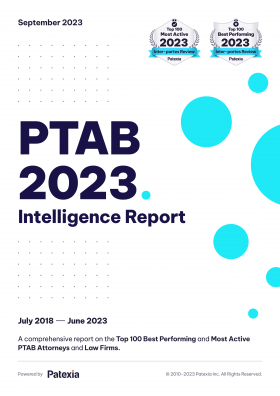Patexia Insight 186: PGR vs. IPR: Analyzing Patent Challenge Outcomes
In the dynamic realm of intellectual property, remaining at the forefront is absolutely essential. Tomorrow marks the release of a pivotal milestone – the seventh edition of our IPR Intelligence Report, now reborn as the PTAB Intelligence Report. This transformation represents another step in our ongoing effort to progressively establish it as the definitive guide for individuals navigating the intricacies of all proceedings conducted before the Patent Trial and Appeal Board (PTAB). The evolution from the IPR Intelligence Report to the PTAB Intelligence Report signifies a broader and more encompassing scope, offering comprehensive insights into the entire spectrum of PTAB proceedings, including Post Grant Reviews (PGR), Covered Business Methods (CBM), and Derivation proceedings (DER), marking a significant expansion of our coverage.
Our assessment period spans a substantial five years, encompassing filings made from July 1, 2018, through June 30, 2023. Within this timeframe, a total of 7,184 PTAB proceedings were initiated. Among these, 6,849 were classified as IPRs, 282 as PGRs, 48 as CBMs, and 5 as DER proceedings. In line with the rigorous standards set by Patexia Intelligence Reports, we have evaluated and ranked the stakeholders extending to both IPR and PGR proceedings. The expansive dataset forms the bedrock of our analysis, provides a robust foundation from which to draw invaluable insights and discern discernable trends in PTAB proceedings.
One of this year's report highlights is the significant disparities discovered between PGR and IPR proceedings’ filings and outcomes, which we will closely examine in this article. This exploration offers valuable insights for practitioners, litigators, and legal professionals, further enhancing their ability to navigate PTAB proceedings effectively.

Our year-over-year (YoY) analysis of IPR data shows fluctuations in activity, ranging from 1,287 to 1,607 proceedings annually. Over five years, there's been an overall decline, peaking at 1,607 filings in 2018, declining by 19.91% to 1,287 in 2019, then increasing by 12.74% to 1,451 in 2020, only to decrease by 10.20% in 2021. In 2022, there was a modest 1.69% increase to 1,325 proceedings. Early 2023 data reveals 4.78% fewer IPR petitions (637) compared to the same period in 2022, notably dropping from 341 to 296 petitions in the second quarter. Regarding PGRs, annual proceedings fluctuate from 35 to 83, significantly lower than IPRs. In 2018, 64 PGRs were filed, decreasing by 32.81% to 43 in 2019, followed by an 86.05% increase to 80 filings in 2020, maintaining at 83 in 2021, and subsequently dropping to 35 proceedings in 2022. Recent 2023 data shows 12 PGRs filed in the first half, compared to 19 filed during the same period in the previous year.
In addition to differences in annual filings, significant disparities exist in the outcomes of PGR and IPR proceedings. As depicted in the charts below, the denial rate for PGRs is notably higher than that for IPRs. Among the terminated cases filed during our study period from July 1, 2018, through June 30, 2023, 51% of PGRs were denied institution, compared to 35.3% of IPRs experiencing the same outcome. Settlements also exhibit disparities, with 31.2% of IPR proceedings resulting in settlements, while only 15% of PGRs achieve the same. Regarding Final Written Decisions, the rates are comparable, with 31.5% in IPR and 28.7% in PGR.
The precise reasons for the disparities between Inter Partes Reviews (IPR) and Post Grant Reviews (PGR) outcomes remain elusive. Nevertheless, a logical starting point for exploring these differences is to examine the inherent distinctions between these two proceedings. Timing, for example, appears to favor IPRs since they can be initiated at various stages of a patent's lifecycle, potentially providing a larger pool of patents for potential invalidation. PGRs instead can be filed no later than nine months after the date of the grant of a patent or of the issuance of a reissue patent. Another factor, estoppel, also seems to lean in favor of IPRs due to their comparatively less restrictive limitations on asserting invalidity arguments in subsequent proceedings when compared to PGRs. Conversely, PGRs appear to enjoy an advantage when it comes to the grounds for invalidation, as they offer a broader scope raising any grounds for invalidity that can be asserted in district court—including subject matter ineligibility under § 101, invalidity based on product prior art under §§ 102 or 103, and invalidity based on written description or enablement under § 112. Nonetheless, PGR petitions remain comparatively low in number when compared to the more commonly pursued IPRs.
The full PTAB Intelligence Report offers a deep dive into the world of IPR, PGR, CBM and DER proceedings. We conduct a thorough analysis at both the patent and claim levels and provide insights into the most active technologies based on IPC codes of challenged patents. We also delve into the examination of technologies with the highest denial rates, instances of successful settlements, and the outcomes of final written decisions. Additionally, we explore the landscape of the most frequently challenged technologies and evaluate the success rates of patent invalidation. Our report goes further by scrutinizing the work of Administrative Patent Judges, assessing their activity, performance, and invalidation rates based on the decisions they've authored. As a standard practice in all our reports, we meticulously rank all PTAB stakeholders, including attorneys, law firms, and companies, based on their activity and performance in IPR and PGR proceedings. This comprehensive analysis aims to provide a clear and insightful perspective on the intricate world of patent challenges and the key players involved.
Stay tuned for more insights related to this report release as well as some of the most active and best performing law firms and companies who have been mentioned by our ITC Intelligence Report 2023.

